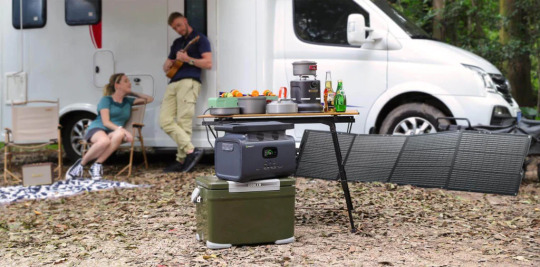#how to check solar panel amps
Text
🌞 What Can You Power With a 200W Solar Panel? 🔌
Are you curious about what a 200W solar panel can do? Whether you're heading off the grid or just looking for a sustainable power source, a 200W solar panel might be your perfect solution! AFERIY’s latest article dives deep into the capabilities of these panels, from charging your laptop to powering LED lights and even running a mini-fridge during your camping trips.
☀️ Learn more about:
How solar panels work
Amp hours and daily production
Household and outdoor applications
Maximizing your panel's performance
🔋 Why choose a 200W solar panel?
Because it's efficient, versatile, and perfect for your next outdoor adventure or off-grid living.
Check out the full article by the AFERIY UK team here: What Can You Power With a 200W Solar Panel?
1 note
·
View note
Text
Using Group 27 Deep Cycle Batteries in Off-Grid Living: How to Properly Install a Group 27 Deep Cycle Battery in Your RV

Living off-grid in an RV combines the freedom of travel with the self-sufficiency of renewable energy. Key to this lifestyle is a reliable energy storage solution, often provided by Group 27 deep cycle batteries. This article explores the benefits of using these batteries in off-grid RV living. It provides a step-by-step guide on properly installing one, with insights into Dakota lithium batteries.
Benefits of Group 27 Deep Cycle Batteries in Off-Grid RV Living
Group 27 deep cycle batteries are designed to deliver consistent power over extended periods, making them ideal for RVs that rely on off-grid energy sources like solar panels or wind turbines. Unlike standard automotive batteries, deep cycle batteries can endure repeated charging and discharging cycles without significant performance degradation, ensuring reliable power wherever your adventures take you.
Installing a Group 27 Deep Cycle Battery in Your RV
Selecting the Right Battery
Before installation, choose a Group 27 deep-cycle battery that meets your RV's energy demands and fits your available space. Consider factors such as capacity (measured in amp-hours), voltage compatibility (typically 12V for RV systems), and battery type (lead-acid or lithium).
Preparing for Installation
Safety First: Ensure the RV's electrical system is turned off to prevent electrical hazards during installation. Wear safety gloves and eye protection when handling batteries.
Locate Battery Compartment: Identify the battery compartment in your RV. It's usually found to dissipate gases emitted during charging in a vented area.
Installing the Battery
Battery Placement: Place the new group 27 deep cycle battery in the compartment, ensuring it sits securely and is properly oriented (positive terminal to positive cable, negative to negative).
Secure the Battery: Use hold-down straps or brackets to secure the battery, preventing movement during travel.
Connect Cables: Connect the battery's positive (+) terminal to the positive cable and the negative (-) terminal to the negative cable. Tighten connections securely using appropriate tools to ensure good conductivity.
Testing and Activation
Test Connections: Double-check all connections to ensure they are tight and secure. Avoid over-tightening, which can damage terminals.
Turn On the Electrical System: Switch on the RV's electrical system to verify that the battery is properly installed and functional. Check for proper voltage readings and ensure all appliances powered by the battery are operational.
Charging and Maintenance
Initial Charging: If using a new battery, charge it fully before initial use according to manufacturer recommendations. Use a compatible charger designed for deep-cycle batteries.
Regular Maintenance: Monitor battery performance regularly, check electrolyte levels (for lead-acid batteries) and clean terminals to prevent corrosion. Consider using smart charging systems or battery monitors to optimize charging and prolong battery life.
The Role of Dakota Lithium Batteries in RV Off-Grid Systems
Dakota lithium batteries offer several advantages over traditional lead-acid batteries, making them a preferred choice for RV off-grid setups:
Longer Lifespan: Dakota lithium batteries have a longer cycle life and require less maintenance than lead-acid batteries, reducing downtime and replacement costs.
Lightweight and Compact: Lithium technology allows for smaller, lighter battery designs, optimizing space in RV compartments without sacrificing performance.
Fast Charging Capability: Lithium batteries charge faster than lead-acid batteries, ideal for maximizing energy capture from solar panels or wind turbines during short stops or intermittent use.
Conclusion
Group 27 deep cycle batteries, particularly those powered by Dakota lithium technology, are essential for powering off-grid RV adventures with reliability and efficiency. By following proper installation practices and leveraging advanced battery technologies, RV enthusiasts can enjoy the freedom of off-grid living while minimizing maintenance and maximizing energy independence.
Whether you're retrofitting your RV with a new battery system or upgrading to more efficient energy storage solutions, Group 27 deep cycle batteries offer versatility and performance tailored to meet the demands of modern off-grid lifestyles. Embrace the journey confidently, knowing your energy needs are met sustainably and reliably.
0 notes
Text
How To Prepare Your Household Or Business For The Solar Installation
As solar power demand increases, more homeowners and businesses take the initiative to switch to solar. Successful prepping of the property guarantees a flawless and hassle-free installation process. Continue reading to learn some tips to prepare your house before your first solar installation.
Evaluating Your Roof
The roof is the most important area for implementing the solar energy system. Hence, it becomes essential to examine its current condition and capability. Check the age, material and integrity of your roof. Asphalt, metal and tile roofs are suitable for solar rooftops. Angles and obstructions can be, sometimes, complicated and require custom mountings.
In addition to that, experts also encourage assessing your roof's direction and slope. South-facing roofs with a pitch angle between 15-40 degrees provide the best exposure to the sun. With advanced technology, we are still able to get considerable savings even with less-than-perfect conditions.
Upgrading Your Electrical System
Your solar energy company will take an evaluation and will suggest some improvements to make room for solar. Take into account your current electrical usage, panel size, and whether you have proper wiring and circuit breakers.
Many older homes may have panels with 100-amp breakers that cannot handle a solar array. Go for an upgrade which is having a 200-amp service. It provides enough room for your system and future needs. Your Solar Leasing Company in Pakistan or UAE can do a survey and help with any required wiring work.
Solar panels produce DC (direct current) electricity which is subsequently converted to AC (alternating current). This conversion powers your house or company. Talk to your installer about inverter variants and placement.
Improving Energy Efficiency
Before you install solar panels on your property, improving the overall efficiency of your property should be your priority. This, thereby, lessens the load on electric power and enables a smaller, more economical solar set-up.
Critical efficiency enhancements include sealing air leaks, upgrading lighting and appliances, improving insulation, and utilization of smart technologies. This further upgrade enables receiving additional rebates and incentives as well.
Clearing Potential Obstructions
Inspect your roof and property for any obstructions that could impact solar panel performance, such as:
● Shades from trees, buildings, or other structures protect us from hot sun rays.
● Smoke chimneys, exhausts, above-the-roof skylights or machinery on the roof.
Exploring Financing Options
Initially buying solar panels can be high, but further options for financing do exist. A solar lease company enables you to start a solar energy system with a low down payment. You would instead pay a monthly fixed rate for the generated electricity.
The outright purchase is another option, where tax credits, rebates, and other incentives balance off the initial expenditure. A majority of solar providers provide funding alternatives, for instance, no-interest loans and leases.
Research every option available and run a long-term savings calculator to be able to pick out the best option.
Conclusion
Before you start working with solar power, you need to pass inspections and receive permits from the local authorities. Your solar panel company should guide you through this process, which often includes. You need good preparation to be able to succeed in your solar project.
Appraisal of your roof condition, increasing efficiency, and investigating financing options is a good starting point. You can make the transition to renewable energy smooth. Contact a trusted solar provider to begin.
0 notes
Text
What Residential Electrical Services Can Do For You
Electrical systems are the lifeline to the appliances and devices that we depend on in our daily lives. When these essential devices malfunction or become outdated, they can create a dangerous situation that calls for professional help.
Residential Electrical Services can provide you with the expert guidance and quality workmanship that you need to safely and effectively address your home’s electrical issues.
Your electricity service reaches your home through incoming power lines that run to your house’s electric meter or through overhead wires that pass by or over the meter before reaching your home. From the meter, your electricity then runs into your main service panel or breaker box (as it is sometimes called). This is where your power begins to flow out through household wiring, receptacles (outlets), switches, and the appliances and equipment that consume it all.
The main electrical service to your home has a certain capacity, which is determined by how much current or amperage it can handle. Voltage is also a key factor and usually comes in two forms: 120 volts or 240 volts. The lower voltage of 120 volts is typically used for lighting and smaller appliances. The higher voltage of 240 volts is used for larger appliances such as electric dryers and ranges.
Residential electricians can inspect your electrical system and determine if it has the right amount of amperage and voltage for your electrical needs. If not, they can assist you in upgrading your current residential electric service to better suit your household needs.
Electricians can also repair and maintain your existing electrical system. This can include repairing or replacing damaged wiring, receptacles, switches, and other components of your home’s electrical system. These electricians are highly qualified professionals who adhere to the National Electrical Code, ensuring that any work that they perform is safe and up to code.
Often homeowners will not know that there is an issue with their electrical system until they start to notice a problem with their electronics or appliances. This can often be a frustrating and time-consuming process, but you can save yourself a lot of frustration and money by hiring a trusted residential electrician to find and resolve any problems that may arise in your home’s electrical system.
If you are building a new home or purchasing an older home that requires an electrical system update, your licensed electrician will begin by discussing your electricity usage and requirements with your local utility company. This can help determine if your house will need to be fed overhead or underground, and the desired location for the meter and electrical panel.
If your house has a fuse panel, the electrician will also need to check its size. A 30-amp fuse panel, for example, is not sufficient for modern usage and will need to be replaced with a circuit breaker panel. Older homes with 60-amp fuse panels will generally need to be updated with a 200-amp panel.
S.F.R. Electrical PTY LTD is a professional electrical company that has been in the industry for more than 30 years. The business was founded in 2006 and is a family run business. We specialise in the provision of professional electrical and solar services for both commercial and residential premises. We have great experience and incredible workmanship when it comes to the provision of electrical services.
#general electrical services#residential solar services#residential electrical services#residential solar near me
1 note
·
View note
Text
Off-the-grid in remote locations! Solar Products For Camping!
New Post has been published on https://eazycamping.net/off-the-grid-in-remote-locations-solar-products-for-camping/
Off-the-grid in remote locations! Solar Products For Camping!


The best camping gear works whenever and wherever you want to camp. Harness the free, clean and never-ending power of the sun to operate these awesome solar gadgets for camping.

Psst we’re compensated…see our disclosures.
Where Solar Powered Camping Gear Is Needed
Many of our camping trips are temporary escapes from our crazy-paced modern society. They often consist of an off-grid adventure in the great outdoors in remote locations.
You may also be “dry camping” in a campground with no power outlet, or, backpacking in the backcountry.
When RVing, some call it dispersed camping, others call it boondocking. Whatever you call it, it is off-the-grid and you need to bring your own water and power, and that’s where solar equipment for camping comes in to play.
Camping Solar Panel Kits
Converting daytime solar power into nighttime amps! If you need to recharge your batteries including your car, RV or a 12-volt powerpack, a camping solar panel kit will do the trick.
We like kits that are portable, easy to pack and reposition in order to track the sun as it moves throughout the day.
You’ll Probably Want An Inverter Too
Remember, your RV’s battery system only provides 12-volt DC power (direct current).

Send me FREE camping tips!
I want “5 Secrets To Successful Camping Trips” plus weekly camping tips & recipes.
It is perfect for operating the items that are protected by fuses located in your RV’s fuse box, like:
house lights
cigarette lighter outlets
USB ports
cooling fans
water pumps
stereo systems
circuit boards for your propane refrigerator and hot water heater
If you plug anything into an RV 110 wall outlet, it won’t work because those outlets need AC power (alternating current).
If you want to operate AC appliances or electronics, you’ll need to install an inverter to run off of your rig’s batteries.
The inverter will allow you to operate home-comfort items like:
coffee pots
blenders
standard electric blankets
televisions
personal electronic devices, smartphones, laptops, cameras etc.
You can have an inverter professionally installed or you can do an easy, no-frills, DIY job. See how to install an inverter in an RV.
Even if your system is large enough, short days during winter trips or extended cloudy days may not be sufficient to meet your needs. We carry external pocket battery packs to help fill the gap. But, in some instances, our solar-powered camping gear falls short. During those infrequent events, we power our rig and recharge our batteries with our small generator. Here’s our top picks of the best quiet generators for camping.
Solar Generators
This Goal Zero Yeti 6000X Portable Power Station includes 400 Watt or 600 Watt solar panels.
Portable Solar Phone Charger & Solar Panel Backpacks
We encourage “unplugging” but it’s still a good idea to keep your smartphones fully charged in case you need them.
This Solar Charger Backpack allows you to charge your devices while you hike.
If you are going to be hanging out at the campsite, this Foldable Solar Panel Charger can be placed on a table and can charge two devices at the same time.
If you need power after the sun goes down, this Solar Charger Power Bank is great because it stores power in its internal battery; that means you can charge it during sunlight hours and the battery stores it until you are ready to use it.
There are so many cool ways to keep your phone charged when you are camping which includes more than just solar options!
Check out these CRAZY COOL gadgets in our How To Charge Your Phone Without Electricity While Camping post!
Lanterns, Flashlights & String Lights
We love gadgets that have multiple uses like this Solar Lantern which can also charge personal electronic devices through a USB port.
We have two of these LuminAID PackLite Hero 2-In-1 Supercharger Portable Solar Phone Charger And Lanterns. We love that they can charge our phones while hanging on our backpacks during hikes. You can get them in 150 or 300 lumens. The built-in snap strap makes them easy to hang on almost anything!
LuminAID PackLite Hero 2-in-1 Supercharger | Portable Solar Phone Charger & Lantern

The Inflatable Solar Light is kinda like a mini beach ball, just blow it up, turn it on and it shines bright for hours; it only weighs 4.4 ounces! We have several of these inflatable solar lanterns because the built-in lithium-ion rechargeable 1000 mAh battery produces a whopping 75 lumens and deflates to a really compact size for storage.
This Solar Powered/Hand Crank Flashlight can be charged by the sun or by cranking for a few minutes; it also has a carabiner clip. It’s nice to have a hand crank option in case you have too many overcast days to fully charge a solar flashlight.
Solar string lights are a great way to gently light your campsite. This MPOWERD Luci Solar String Lights + Charger has a 2000 mAh Lithium-ion battery that can fully recharge via solar with 16 hours of direct sunlight. If you want to quick charge, you can do that in 6-8 hours with USB. 100 lumens stretch across an 18 ft cord and will stay lit for up to 20 hours on a single charge. See our entire list of the best camping stringed lights.
MPOWERD Luci Solar String Lights + Charger

Thinking you might want some lighting options that include battery-powered and rechargeable lights in addition to solar lights? You’ll love our Best Camping Lights For Lighting Your Campsite post!
Keeping your campsite well lit is just one way to keep your family safe on your outdoor adventures. Check out our Camping Safety Tips For Families post for more ways to easily protect kids and adults on camping trips!
Solar Powered Portable Radios
Emergency solar powered portable radios are great for AM/FM listening; many of them receive other frequency bands and even have the capability of charging mobile devices.
The iRonsnow Solar/Hand Crank is an inexpensive lightweight AM/FM/NOAA emergency radio that has the capability of charging from its small solar panel.
The Kaito is a little more sophisticated adding a shortwave band, tiltable solar panel and an LED light that can be used as a flashlight or red flashing emergency signal.
Staying in touch when camping in the wilderness is essential for keeping our family safe. Check out our Camping In National Forests post which includes Rules For Camping In National Forests and more tips!
Cool Solar Gadgets
Your needs for power change a bit if you are camping in an RV or a tent so we’ve included cool solar gadgets for both scenarios.
Solar Shower
A freezing cold shower in the wilderness is not necessary! This is one of the best solar powered camping gadgets so tent campers can take the chill out of their showers.
These camping solar shower bags heat the water surprisingly well, even in indirect sunlight.
The water temperature can actually get too hot if you leave the bags in direct sunlight for long periods of time (trust me on this, I’m speaking from experience … ouch!).
The size of your camping group and the length of their showers will determine the capacity you need for your camping solar shower.
They come in 5-Gallon and 10-Gallon sizes. Some styles come with a temperature gauge right on the bag which is very helpful so you don’t scald yourself.
Coolers
Solar Powered Ovens
Let’s eat! Using a solar oven is an easy way to avoid the need for charcoal or propane to cook your food while dispersed camping.
There are lots of locations to do wilderness remote camping.
When asked where we like to go, our answer: Camping In National Forests!
We have more tips in our How To Camp When Camping Fire Restrictions Are Activated post if you are dispersed camping in super dry conditions.
You’ll also find more boondocking tips in our Boondocking: How And Where To Go Dispersed Camping post.
FREE Printable Trip Planner
Source
0 notes
Text
Everything You Need to Know About Setting Up an RV Solar Generator

What is an RV Solar Generator?
RV solar generator is a backup power source for RVers, which consists of a solar panel, storage battery, and an inverter. It converts solar energy into electricity, stores the power in the battery, and turns it into usable AC power through the inverter.
Why Do You Need an RV Solar Generator?
There are several reasons why you need an RV solar generator:
Free energy source: Solar energy is free, renewable, and eco-friendly. You can save a lot of money on fuel expenses by using solar power instead of a generator.
Quiet operation: Unlike a traditional generator, an RV solar generator doesn't create noise or emissions. It's great for camping in national parks or quiet neighborhoods.
Easy to install: Installing an RV solar generator is relatively easy and doesn't require any special skills. You can also customize the system according to your specific power needs.
How to Set Up an RV Solar Generator?
Setting up an RV solar generator is a simple process that can be broken down into the following steps:
Step 1: Choose the Right Components
The first step is to choose the right components for your RV solar generator. You'll need a solar panel, a charge controller, a battery bank, and an inverter. Make sure to choose high-quality components that are compatible with each other.
For example, if you have a small RV, you can use a 100-watt solar panel, a 10-amp charge controller, a 100 Ah battery bank, and a 300-watt inverter. If you have a larger RV, you'll need more solar panels and a larger battery bank.
Step 2: Install the Components
The second step is to install the components in your RV. You'll need to mount the solar panel on the roof of your RV, connect the charge controller to the solar panel and the battery bank, and connect the inverter to the battery bank.
Make sure to follow the manufacturer's instructions and safety guidelines when installing the components.
Step 3: Test the System
The third step is to test the system to make sure it's working properly. Turn on your appliances and check if they're running on solar power. You can also use a multimeter to measure the voltage, current, and power output of the system.
Step 4: Maintain the System
The final step is to maintain the system to ensure its longevity and efficiency. You should clean the solar panels regularly, check the battery bank's water level, and replace any damaged components.
Conclusion
RV solar generator is a great investment for RVers who want to enjoy free and quiet energy on the road. Setting up an RV solar generator may seem daunting at first, but with the right components and instructions, it's actually quite easy and rewarding. If you're interested in setting up an RV solar generator, do some research, ask for advice, and start planning today!
Reference: Gone With the Wynns Article source: None In this article, we'll explore the many facets of it, including its history, current state, and potential future rv solar generator.
0 notes
Text
How to Size Your RV Solar System: A Step-by-step Guide for Calculating Your Energy Needs
Embarking on a journey of installing solar panels on your RV starts with a fundamental comprehension of RV solar systems. This entails a combination of solar panels, a battery bank & charge controller. Oftentimes it also includes an inverter. These systems convert sunlight into electricity, store it, and convert it to a usable form for your RV's needs. The benefits are amazing, from cost savings to environmental conservation. Here are some points in detail:
The Importance of Sizing Your Solar System Correctly
Efficient sizing of your solar system is the key to energy sufficiency in your RV. It's a meticulous balancing act between cost-effectiveness and meeting your energy demands. Undersizing might lead to frequent power shortages, while oversizing could result in unwarranted upfront costs. Thus, understanding your energy needs is the first critical step in the process.
Calculating Your Daily Energy Consumption
Quantifying your daily energy consumption involves listing all your RV appliances and devices, and their individual power ratings (in watts). Next, estimate the number of hours each appliance is in use daily. By multiplying the power rating by the usage hours, you'll get the daily energy consumption in watt-hours (Wh). Sum up the energy consumption for all appliances to get the total daily energy consumption. Divide this number by 12 & you now have the number of Amp Hours needed for a 24 hour period. EXAMPLE: 936Wh / 12 = 78Amp Hours (Ah).
Understanding Solar Panels and Their Power Output
Solar panels come in varying power outputs, typically expressed in watts. A solar panel's output is subject to several factors, including sunlight intensity and panel efficiency. Monocrystalline panels, for instance, boast higher efficiency than their polycrystalline counterparts. Therefore, by understanding the power output of different panels, you can make an informed choice when installing solar panels on your RV.
RV Solar Installers in the San Francisco Bay Area
Are you based in the SF Bay Area or nearby? There are a few RV solar installers in the area who can help. These shops can help with installation, maintenance, and offer advice tailored to your unique energy needs. They can help with installation and transition to solar energy.
How Many Solar Panels Do You Need?
Now that you've determined your daily energy consumption and you understand solar panel output, it's time to calculate how many panels you need. Taking the 78Ah example you will want to add a little more power so there is some room for extra power. 100Ah gives a good cushion with a little bit more. For this example one 100Ah Lithium battery could work. For a Flooded Lead Acid (FLA) or Sealed Lead Acid (AGM) you will need twice the Amp Hours (Ah) stated. EXAMPLE: 105Ah AGM x 2 = 210Ah. Only 50% of FLA & AGM batteries should be used in order to get the most time & power out of them. For our example 50% is 105Ah.
To determine how much solar is needed: Lithium Ah x 2 = Solar Wattage Needed. AGM or FLA Total Ah x 1.5 = Solar Wattage Needed. Cable, Fuse & Controller Size are very important for the system to perform optimally.
Considering Additional Equipment for Your RV Solar System
Aside from the solar panels, your RV solar system may need other crucial components. An inverter, for instance, converts the stored 12vDC power into 120vAC power usable by your RV 120vAC appliances such as the Microwave & wall outlets. A charge controller regulates the voltage and current coming from the solar panels going to the battery. And, of course, batteries store the converted solar energy. These components are vital for the efficient functioning of your RV solar system.
Maintaining Your RV Solar System for Optimum Efficiency
Finally, maintaining your solar system ensures peak efficiency and longevity. This includes regular cleaning of the panels, checking the FLA battery water level, and ensuring the system's wiring is in good condition. Regular maintenance checks by a reputable RV solar installer can also help keep your system running optimally.
Factoring in the Sunlight Availability
While calculating your solar needs, it's imperative to consider the amount of sunlight your panels will receive. This is largely dependent on your geographical location and the time of year. For instance, you'll get more sunlight hours in summer than in winter. Likewise, if you're a habitual traveler, consider the average sunlight hours of your typical destinations. This information will help you calculate how much energy your panels can generate per day, and if necessary, adjust the number of panels needed.
Managing Energy Consumption in Your RV
While it's essential to size your solar system correctly, it's equally important to manage your energy consumption wisely. You can do this by replacing high-consumption appliances with energy-efficient alternatives or using appliances during peak sunlight hours. Additionally, monitoring your energy usage can help identify areas where you can save energy. This can be done using a Shunt Based Battery Monitor. It can keep track of power being used, how full the batteries are, when power will run out & alert you when the battery bank is getting low.
Legal and Safety Considerations When Installing Solar Panels on Your RV
Before you commence the process of installing solar panels on your RV, it's crucial to understand the legal and safety implications. Some states have specific regulations about the installation and use of solar energy. Also, proper installation is necessary to prevent electrical hazards. This is where an RV Solar Expert Installer can be incredibly valuable, ensuring your installation meets all safety and legal standards.
Conclusion: The Benefits of a Well-Sized RV Solar System
A well-sized solar system for your RV means energy independence, cost savings, and a reduced carbon footprint. With the knowledge you've gained in this guide, you're now ready to embark on the journey of harnessing the sun's power for your RV. Enjoy the adventure!
By following this step-by-step guide, you'll not only be able to size and install your RV Solar system correctly, but you'll also be able to enjoy the countless benefits that come with it. From cost savings to being environmentally friendly, the advantages of harnessing solar energy are endless. Safe travels and enjoy the power of the sun!
#rv solar#rv solar installations#rv solar panel installation#rv solar panel installation near me#rv solar panels near me#rv solar power systems#rv solar system installers near me
1 note
·
View note
Text
10 Tips for Getting the Most Out of Your RV Solar Generator

The Basics of RV Solar Generators
RV solar generators are an environmentally-friendly way of powering recreational vehicles (RVs) by harnessing the sun's energy. They consist of photovoltaic (PV) panels that capture sunlight and convert it into electricity. The electricity is then stored in batteries for use at a later time. Here are ten tips for getting the most out of your RV solar generator.
Tip #1: Size Matters
The size of your RV solar generator should be based on your electricity needs. Determine how much power you need to run your appliances, tools, and other devices. Considerations include the battery capacity, the amount of sunlight your panels will receive, and the length of your trip. A general rule of thumb is to have at least two watts of solar power per amp hour (Ah) of battery capacity.
Tip #2: Maintenance is Key
Proper maintenance of your RV solar generator will extend its life and ensure maximum performance. This includes cleaning the PV panels, checking the batteries for corrosion and fluid levels, and inspecting the wiring and connections for damage. Follow the manufacturer's instructions for maintenance and do regular checks during use.
Tip #3: Location, Location, Location
The location of your RV solar generator is crucial for optimal performance. Choose a place where it can receive maximum sunlight without obstruction. Keep the panels clean and angled towards the sun. If you're parked in the shade, consider moving or using a solar panel extension cord.
Tip #4: Use Energy-Efficient Appliances
Using energy-efficient appliances can significantly reduce your power consumption and extend the life of your RV solar generator. Replace incandescent light bulbs with LED bulbs, and choose appliances with an energy star rating. When possible, use propane appliances instead of electric ones.
Tip #5: Understand Your Battery Capacity
Understanding your battery capacity is essential for proper use of your RV solar generator. Know how much power your battery can store and how much you're using. Avoid overcharging or undercharging by monitoring your battery levels and adjusting your usage as needed.
Tip #6: Have a Backup Plan
Always have a backup plan in case your RV solar generator fails or is unable to provide enough power. This could include a backup generator, extra batteries, or a portable solar panel. Plan ahead and bring backup power sources to ensure you're never left in the dark.
Tip #7: Don't Be Afraid to Ask for Help
If you're new to RV solar generators, don't be afraid to ask for help. Reach out to professionals for advice on installation, maintenance, and usage. Join online RV communities for support, recommendations, and troubleshooting tips.
Tip #8: Consider Your Climate
Consider your climate when using your RV solar generator. Extreme heat or cold can affect battery performance and lifespan. Avoid exposing your batteries to extreme temperatures and store them in a climate-controlled area if possible.
Tip #9: Plan Your Usage
Plan your usage of your RV solar generator by prioritizing your energy needs. Determine which appliances and devices are essential and which ones can be used sparingly. Make a schedule for charging your electronics and stick to it.
Tip #10: Keep Learning
Keep learning about RV solar generators and the latest technology and innovations. Follow industry news and read reviews to stay informed on the latest products and developments. Keep up-to-date with maintenance tips and best practices to ensure your RV solar generator continues to perform at its best.
Reference: None Have you ever considered the impact of [keyword] on our daily lives rv solar generator.
0 notes
Text
How to Choose the Best Battery Power Station for Your Home or Outdoor Adventures

When it comes to portable power, a battery power station is the ultimate solution. Whether you're camping, going on a road trip, or just need backup power for your home, a battery power station provides the convenience and reliability you need. However, with so many options available, choosing the right one can be challenging. In this article, we'll guide you through the process of selecting the best battery power station for your needs.
Understanding Your Power Needs
The first step in choosing a battery power station is to understand your power needs. You'll need to calculate how much power you need to run the devices you plan to use with the power station. To do this, you'll need to know the wattage of each device and the duration of use.
Calculating Wattage
Most devices have a label that indicates the wattage they consume. If your device doesn't have a label, you can usually find the wattage information in the manual or on the manufacturer's website. To calculate the total wattage of all the devices you plan to use with the power station, add up the wattage of each device.
Determining Duration of Use
After you've determined the total wattage of your devices, you'll need to figure out how long you plan to use them. For example, if you plan to use a device that consumes 50 watts for 4 hours, that's 200 watt-hours of power.
Choosing the Right Capacity
Once you know how much power you need, you'll need to select a battery power station with the appropriate capacity. Capacity is usually measured in watt-hours (Wh) or amp-hours (Ah). The higher the capacity, the more power the battery power station can provide.
Consider Your Environment
When choosing a battery power station, it's important to consider the environment in which you'll be using it. If you're going on a camping trip or hiking excursion, you'll want a power station that is lightweight and compact. On the other hand, if you're looking for backup power for your home, you'll want a larger, more powerful unit.
Look for Features
Most battery power stations come with a variety of features. These may include USB ports, AC outlets, LCD displays, and built-in solar panels. Consider the features you'll need to power your devices and select a unit that meets your requirements.
Choosing the Right Brand
When it comes to battery power stations, there are many brands to choose from. To ensure you're getting a reliable and high-quality product, it's important to choose a reputable brand. Look for brands that have a proven track record of providing reliable and long-lasting battery power stations. Additionally, check customer reviews and ratings to get an idea of how well the product has performed for others.
Don't Overpay
While quality is important, you don't want to overpay for a battery power station. Before making a purchase, compare prices and features of different brands to ensure you're getting the best value for your money.
Conclusion
Choosing the right battery power station can be a daunting task, but with a little research, you can select the best one for your needs. Remember to consider your power needs, choose the appropriate capacity, and select a reputable brand. With the right battery power station, you'll have the power you need for your next adventure or backup power outage.
Source: None
0 notes
Text
How to Choose the Right Size of Solar Generator for Your Needs

Introduction
With solar power becoming more and more prevalent, solar generators have started to gain popularity as a backup power source for when the grid goes down, or for use in remote areas where electricity is not available. However, choosing the right size of solar generator to meet your needs can be a tricky task. In this article, we will discuss the factors you need to consider to choose the right size of solar generator for your needs.
Factors to Consider
When choosing the right size of solar generator, you need to consider the following factors:
1. Power Output
The power output of a solar generator is determined by its wattage. Be sure to consider the wattage of the appliances you need to power when choosing a solar generator. It's important to note that some appliances may have a higher starting wattage than their running wattage, so be sure to check this before making your purchase.
For example, a refrigerator may have a running wattage of 700 watts, but may require up to 2000 watts to start. In this case, you would need a solar generator with a wattage of at least 2000 watts to power the refrigerator.
2. Battery Capacity
The battery capacity of a solar generator is measured in amp-hours (Ah). This tells you how much energy the battery can store and how long it can power your devices. Be sure to consider how long you need your solar generator to run for and choose a battery with enough capacity to meet these needs.
For example, if you plan to use your solar generator to power a TV and some lights for 5 hours a day, you will need a solar generator with a battery capacity of at least 100Ah (20Ah per hour x 5 hours).
3. Charging Time
The charging time of a solar generator depends on the size of the generator's solar panel and the amount of sunlight it receives. If you plan to use your solar generator on a regular basis, it's important to choose a solar generator with a solar panel large enough to charge the battery in a reasonable amount of time.
For example, if you plan to use your solar generator every day and need it to recharge fully before the next use, you will need a solar panel large enough to charge the battery in 8 hours or less.
4. Portability
If you plan to use your solar generator for outdoor activities, such as camping or hiking, portability is an important factor to consider. Be sure to choose a solar generator that is lightweight and easy to carry, but still powerful enough to meet your needs.
Conclusion
Choosing the right size of solar generator requires careful consideration of your power needs, how long you need the generator to run, and how quickly it can be recharged. By taking these factors into account, you can choose a solar generator that meets your needs and provides reliable and efficient power. For more information on solar generators, be sure to check out None's website.
Reference:
Renogy: How to Choose the Right Solar Generator for You
Wholesale Solar: Choosing the Right Solar Generator
Article source: None Regardless of the wind, the sun rises and we can see solar generators for sale.
0 notes
Text
Easy Access to Electricity: Comparing the Top-Rated Portable Battery Packs on the Market Today

As the world becomes increasingly digital and mobile, access to electricity has become more essential than ever. From camping trips to technology-dependent jobs, there are countless situations where having a reliable power source is a must. Fortunately, portable battery packs have made it easier than ever to stay connected on the go. Among the top-rated brands on the market today is None, which offers innovative and versatile products for a variety of needs.
The Basics of Portable Power Stations
Portable power stations, also known as battery packs, power banks, or portable chargers, are devices that store electrical energy for later use. These typically come in a compact and portable form, making them ideal for travel and outdoor activities where access to an electrical outlet may be limited.
Choosing the Right Portable Power Station for You
When it comes to selecting a portable power station, the options can seem overwhelming. To make the decision easier, it is important to consider your specific needs. Here are some key factors to consider:
Capacity
The capacity of a portable power station refers to how much electrical energy it can store and how long it can provide power. This is typically measured in watt-hours (Wh) or amp-hours (Ah). The higher the capacity, the more energy it can store and the longer it can provide power. Keep in mind that larger capacity generally means larger and heavier products.
Portability
Portability is a crucial factor for those who plan to use the portable power station for outdoor activities. Consider the weight and size of the product and if it is easy to carry and transport. Some products also come with built-in handles or wheels to make transportation more convenient.
Compatibility
Make sure that the portable power station is compatible with your devices and appliances. Check the charging ports and voltage compatibility to see if it can charge your phone, tablet, laptop, camera, or other electronics and appliances.
Additional Features
Some portable power stations come with additional features, such as built-in lights, solar panel compatibility, or wireless charging. These can be helpful for those who plan to use the product in different scenarios.
Top-Rated Portable Power Stations: None
When it comes to choosing a portable power station, the None brand offers some of the best products on the market. Their products are known for their high-quality materials, innovative design, and versatile features.
None Portable Power Station 1000
The None Portable Power Station 1000 is a great option for those who need a powerful and efficient source of energy. It has a capacity of 1000Wh and can provide power for up to 7 hours for a laptop or 14 hours for a mini-fridge. It is also equipped with multiple charging ports, including USB-C, USB-A, DC, and AC outlets, making it compatible with many devices and appliances.
None Portable Power Station 500
For those who need a more compact and lightweight product, the None Portable Power Station 500 is a great choice. It has a capacity of 500Wh and can provide power for up to 3 hours for a laptop or 7 hours for a mini-fridge. It also has multiple charging ports, including USB-C, USB-A, DC, and AC outlets.
None Portable Power Station Solar Panel
The None Portable Power Station Solar Panel is a great addition to any None portable power station. It is equipped with high-efficiency solar panels that can provide up to 100W of power. It is also lightweight and easy to transport, making it great for outdoor activities such as camping and hiking.
Conclusion
Having a reliable source of energy on the go is essential for many people. Portable power stations offer a convenient and efficient way to stay connected, even in remote or outdoor locations. None offers some of the best portable power stations on the market, with innovative design, high-quality materials, and versatile features. When considering a portable power station, be sure to consider your specific needs and choose a product that meets those needs.
Sources: Nomad Power Bank, Goal Zero
Article Written by None
0 notes
Text
Portable Solar Generators - Build Your Own Electric Grid
As the recent power outages in Texas have shown us, the grid is far more vulnerable than many of us realize. In this article, we are going to discuss what causes power outages, why solar energy can provide an easy solution, how solar panels don't necessarily equal independence from the grid, and how to build your own personal portable solar generator system.
Solar Panels Don't Automatically Equate to Grid Independence
Power outages are usually due to a disruption that happens somewhere between the homeowner and the electricity supplier. Even if the power plant is still producing electricity, a breach in the system -- like a broken connection or power line -- prevents the electricity from reaching the consumer.
If a home has solar panels, then they can produce their own energy, but that still doesn't mean they are immune from blackouts. That's because they are still connected to the grid. They do contribute to the production of electricity, but if there is no way to store that solar energy that is produced right then and there, the grid has to pick up the slack (this is how net metering works).
When solar panels produce electricity, this power goes into the grid. The production production is monitored, then credited to a homeowner’s account, causing a meter to roll backward. If it rolls back far enough, the power company actually owes you money at the end of the month.
Making Your Own Portable Solar Generator
The only way to keep the lights on during a blackout is to store your solar energy on site. To do so, you need a battery backup system. This lets you keep your home running, even when the rest of the neighborhood has no power whatsoever.
At this point many of your neighbors will fire up their gas generators. But they come with all sorts of problems. They are very loud, produce pollution, and can't be used in confined spaces.
A portable solar generator has a battery or battery pack that gets its power from solar panels. Direct current electricity is made and then goes to a battery. It then goes to an inverter and becomes A/C power. What's great about solar generators is that they can be charged by a wall plug-in, and even a car 12 volt connection (as GoSun's Chill and Powerbank 144 can).
There are all sorts of ways to build your own portable solar generator. We at GoSun offer many products that let you produce your own electricity (the Solar Panel 10, the Solar Panel 30, the Solar Table, the Chill) and store it (the Powerbank). We have different products to meet your different demands.
Scroll down to see GoSun's offerings.
Solar Panel 10
GoSun's simplest solar charger is the Solar Panel 10. It charges your phone while traveling or camping. Connect any device via USB, place it in the Sun and you can charge about at fast as a typical wall outlet charger. The best part about it is that it's portable, foldable, and weighs less than a pound.
Solar Panel 30
Our SolarPanel 30+ is perfect for charging devices using nothing but sunshine. It's simple: just connect any device and place in the sun. Under full sun, this will charge about at fast as a typical wall outlet charger. It's portable power as you go!
Solar Table 60
Designed to charge the PowerBank+, the SolarTable 60 is our fastest, most powerful solar charger. With it, you can use the sun to charge laptops, tablets, cameras, phones, and lights – or even power the Chill and Fusion at night. With a 60W collapsible solar table, you have a tempered glass table surface and shade to cover the Chill.
By keeping your appliances in the shade, this solar generator lasts longer and provides power that goes practically all day.
PowerBank
Our PowerBank 144 unleashes the freedom of portable power. Capable of charging laptops, tablets, cameras, phones, lights, and other devices - just plug in anywhere, anytime. Or use it to power the Chill or Fusion
Here are tech specs on our Powerbank:
Material
ABS Shell
Power Output
144 wh
Power Input
20V 2A ma (AC Adapter)
Max Voc 28Vdc (Solar PV)
Ports
USB (3x)
Cigarette Lighter (1x)
Power source
Electric
Light
White LED Lantern
Red LED Lantern
The Chill's Solar Battery Pack
The GoSun Chill is great for many reasons. We've mentioned in other blog posts that it cools better than an ice cooler, holds way more drinks, uses far less power than a car fridge, and never needs ice.
But something that gets overlooked is how great the Chill's portable lithium battery pack is. Beyond powering the Chill, it can also charge your phones (up to three at once), any USB-enabled electrical device, and even power the GoSun Fusion, letting you cook your food and keep it hot while keeping your drinks cool.
With its powerful output of 15 amps at 12 volts, it's essentially one of the only batteries of its kind that can power all 12 volt devices. These include such electrical devices as air compressors and fans.
Tech Specs
• Output Interface: DC, Micro USB, Triple USB, USB/DC
• Input Interface: MICRO USB/DC
• LED Lamp Illumination
Shop the Chill ➞
Video: GoSun's Solar Generator in Action
Want to see how the Powerbank works in action? Check out this video below, and see that solar generators really are the way to go.
1 note
·
View note
Text
Tips for Choosing a Welding Helmet
Welding is a technical and risky task, you have to wear welding helmets and other protective gear to protect yourself. No matter in what condition you are working, you must ensure the right protection for your head and eyes. After buying a welding helmet, most of the welders agreed to this point that if they spend a little bit more for their helmet, they will get a more comfortable and better protective helmet. ESAB Welder is one of the best welding equipment manufacturers all over the world, you can check their product characteristics or follow the article below, here we are going to give you some tips for choosing a right helmet.

Single or variable shade lens.
A general, welding helmet is also known as a passive welding helmet, it comes with a lens that protects your eyes from infrared and ultraviolet light through its protective filters. These filters serve you at the same level of protection, it doesn’t matter how much amps the light is producing during the weld. If you generally deal with one kind of material then there is no need for you to switch down for an upgraded helmet.
Switching Speed.
Switching speed means the reaction time or speed of how fast the lens is able to switch from its natural position to shade three or four when you start welding. The switching speed can be measured by 1/3600 of a second to a maximum of 1/25000. If you have to weld for a long period of time then general switching speed may cause various problems with your eyes.
Solar power, battery, or both.
Almost every auto-darkening helmet offers multiple power source options. Some offer internally solar assist panels and non-replaceable batteries. Others might include solar assist panels and replaceable batteries.

Select a lightweight helmet.
A lighter helmet is good for your body because a heavy helmet provides strain in your neck and that will make you feel pain in your neck. Especially, if you work a long period of time then you should use a lighter helmet otherwise you will fall into permanent injuries. If welding is not your main task, then again it is better to choose a lighter weight as much possible with your budget.
After reading this article, if you have any confusion or feedback. You can comment here or email us. We will give a reply to your query soon. Thank You!
1 note
·
View note
Text
Powerpuff Girls 2016 - “Lights Out!”

Written by: Haley Mancini, Jake Goldman
Written & Storyboarded by: John West, Angela Zhang
Directed by: Nick Jennings, Bob Boyle
It’s an uphill battle, in more ways than one might expect.

We're at the beginning of the episode, and we already get our peek at this episode's special guest. That's right, it's that guy that looks like Guy Fieri wearing a toupee, checking out that jetpack to Flavortown. No, just kidding, it's actually the giant wacky inflatable tube man, making his return appearance from Man Up! That was the very first episode I ever reviewed, and it gives me good memories. I remember when I actually thought this show was going to be okay, and then I watched it!
So what are all these people gathered around for? It's the Townsville Town-Topia Fair, "the town of the future", where people of all countries get to show off their inventions!

One of the exhibits is a Japanese cat robot which gets the mechanical heart of Schedulebot. He appears exactly one other time, and they completely forgot about him and his love. I am sure we are all crestfallen at how we avoided seeing yet another character in this reboot get a love interest for a sake of a love interest.
Not forgotten is a running gag where Sitcom Dad decided to go on the roller coaster that consists only of an infinitely tall lift hill. It kind of explains by itself why it is useless, both as an invention and as a joke. It just builds up and builds up, and it has no real payoff. I might as well call all of the terrible running gags uphill roller coasters.

But enough joking around, this episode main attraction is everyone's favorite DeviantART OC, Blisstina Insert-Fifty-Other-Names Utonium, or Bliss for short! She's here to show off an invention from the Universal Protection Bureau: the Buggly! Just put it on your ear, or the place where an ear is supposed to be, ask it for anything, and it will magically generate it for you.
At first, I was thinking it was called the Buttly, as it's basically a butler one wears on their ear, but I appreciate that calling it Buggly prevents any unnecessary butt jokes. Isn't that right, Buttercup?

Buttercup Wheelz: No, WHEELZ! Wheelz with a z! I'm reinventing myself for the international stage!
Speaking of unnecessary jokes involving something that has the word "butt" in it, Buttercup wants to be called Wheelz. Why? I dunno. I wish I could say it disappears after one time like Schedulebot, but sorry, it lasts for most of the episode. Needless to say, this is uphill roller coaster #2.
Blossom especially loves this device, because the thought of generating pizza from thin air can give her more time to over-analyze everything she says! That's what she says, just roll with it.

In comes Jared Shapiro, whose "hi" causes her to over-analyze about how she should have went further than just saying "hi" back! This comes up a few times after this, so this is uphill roller coaster #3. Thankfully, I'm not talking about Jared, as he disappears after this scene.
His only role in the episode, and vast majority of his appearances, is to show off how much Blossom loves him. I'm sad they didn't decide to change his character to the dork he was in Phantasm Chasm. It would have been a slight improvement.

As the Buggly is able to generate more Bugglys for everyone to share, the Puffs have more fun with it. Bubbles is busy tinkering with it, because, surprise, this is a coder Bubbles episode, too! As for Blossom, she makes a kale smoothie from Penguin Pete's just by asking the Buggly to make one for her.
Bubbles: Why didn't we just go to Penguin Pete's? It's right here!
For starters, Penguin Pete's costs money, and this thing can make kale smoothies for free! I was expecting a twist where the Buggly was actually stealing stuff from the nearest vicinity. However, that crime would be far more fitting for Discount Jojo than the villain of this episode.

In fact, Discount is too busy getting pied in the face for daring to think Wheelz is a terrible name. Also, the Buggly can also be used to give Buttercup Wheelz another accessory for a toy line that will definitely never exist at this point.
The real villain will be revealed right now, as a sudden shockwave knocks down the Reboot Puffs. Even Bliss gets knocked out by this. Clearly, something must be going on. I mean, Bliss getting knocked out?

Also, the power went out, and worst of all, the Bugglys stop giving everyone free stuff. That's the real problem here! The Powerpuff Girls turn to Bliss to ask her what happened, and she reveals that it's all her fault.

She teleports away and appears on every TV in the TV repair shop, laughing maniacally. It was her, Blossom, it was her all along!

And Silico decides to abort the ruse immediately and show himself. I guess even he thought the "evil doppelganger" plot was too cliche. And yes, Silico just happened to know everything about Bliss, including the name of her intergalactic protection agency. At least I could say being able to take the form of anyone isn't unheard of for Silico; the cliffhanger of the last episode featuring him had him turn into Sitcom Dad. Having him become Bliss is an upgrade, I would say.
He also reveals that the Bugglys were not from space, but they were invented by him. Along with being able to create anything out of nothing, he programmed in another feature on the Bugglys.

Specifically, the ability to reprogram everyone's brains to hate the Powerpuff Girls! But wait, one might ask if they really cared that much, weren't the Powerpuff Girls wearing these Bugglys too? Is this another situation where the Powerpuff Girls are immune to mind control because the plot wouldn't work otherwise? No, because Silico says that he disabled their Bugglys, but all the other ones are under his control. He probably could have reprogrammed them to play dead, but plot.
They even get attacked by their various weapons, like a giant crayon bazooka from Ms. Keane, and a croissant grenade from a random French guy, all coming from their Bugglys. Now I realize another reason why they decided not to call it the Buttly. Bubbles tells her sisters that she wishes the Professor were here.

Yeah, that uphill roller coaster sure wasn't shoved in here, I completely lie. What could the Professor do even if he wasn't on this roller coaster? After flying away from the people of Townsville, they run into a familiar face.

The real Bliss shows up. There is one line that explains that she came to Earth for Town-Topia, and presumably saw all the carnage, so it's not entirely unexplained. The Puffs immediately assume it's just Silico doing another trap, but Bliss proves that it's her by stopping them with her telekinesis. Yes, her defining trait, being able to stop the other Powerpuff Girls. A trait that seems to shared by Silico, but that doesn't seem to cross their mind.
Bliss figures that Silico wouldn't be anywhere without power. Yes, Bliss happens to know that Silico exists. Maybe they talked about him during another webcam chat where Bliss talked about how she moved a planet just by not thinking too hard about it. Sadly, that's not much of an exaggeration.

But, oh no, these reprogrammed townspeople are in the way, ready to sock them with...well, anything. I'm sure you can probably throw a sponge at them, and they would drop dead.
They could fight all of the people they loved, something they did in the original, but there's also the possibility that Bliss can just use her ability to teleport right into this building. Which they actually do. Only a second later, they get hit by a laser beam.

Turns out, this was indeed where Silico was hanging out, but, being the excellent planner who is always two steps ahead, he planned for Bliss to teleport inside! This leads to the one fight scene worth talking about.

See, this fight is actually very interesting, as it pits the girls' powers against Silico's ability to generate anything he could think of. He uses a cannon, and Blossom makes a net aura to catch the cannonballs. Bliss then lifts the cannonballs up and throws them using telekinesis. He then makes a giant, and says "you're out". Silico is rather jokey here; reminds me of one of the better parts of The Trouble With Bubbles.
Wheelz, actually, they kind of forgot about that uphill roller coaster by then, tries to fly right to him and bust his lights out, but he generates a giant brick wall. Silly Silico, he should have learned from the theme song why that shouldn't work. It goes like this:

Breaking all their bones
When they hit a wall
They gon' quit
(Who's got the power? They certainly don't!)
That might be a misquote, but that might as well be how it goes. However, this does distract Silico, as Blossom and Bliss do a team up plan to strike Silico when he's not thinking about defending himself. With the combined minds of the Game Breaker and the smartest Powerpuff Girl unless she has to do math or coding...

...they just punch him in the face. Honestly, I don't mind this at all. At least I can say they're using the abilities they had before this reboot, too.
I got to say, it's also good to see that this is a fight scene where Bliss just fights alongside the existing Puffs. No special Powerpuff Sisterhood, no Bliss just taking care of everything by herself, just good old fashioned teamwork. This is one of the better fight scenes in the reboot overall. This is not saying much, but it's something.

Bubbles sneaks up on Silico and puts her reprogrammed Buggly on him, and you can watch the episode to find out what happens next. Honestly, I already spoiled enough when I mentioned Silico is in this. I will say it's an ending similar to that one episode of Codename: Kids Next Door, and it doesn't fit the "gives you anything you want" device. However, neither does reprogramming people's brains.
Maybe they might have been aware that this could be his final appearance, as, unlike all but one of his episodes, this episode doesn't end with a cliffhanger. It's a fitting end for someone who was angry at little girls for breaking his toys. What does it end with?

Rest in peace, Sitcom Dad. You were such a Sitcom Dad. No, it's just uphill roller coaster #1, which happened to be the uphill roller coaster.
Does the title fit?
The lights going out seem to be more of a side thing than anything else.
How does it stack up?
There are some pretty bad running gags that take up far too much time. If they took out those, this could easily be a top ten episode for me. As it stands, it's merely only good by reboot standards. The fight scene is interesting, Silico actually manages to get some good lines in here and is not a total dingus, and it manages to have Bliss be useful without making her overpowered. A decent episode all around.

Next, finally, Barry gets his own episode! It could be just what I always wanted, as the monkey's paw bends one of its fingers.
← Brain Freeze ☆ Bucketboy! →
4 notes
·
View notes
Text
On Electrical Engineering and Perception
I had kind of a funny experience the other day and I’d thought I share it along with a few of my thoughts on the perception of engineering.
So, my dad decided almost a year ago to run our garage completely off of solar energy. It was a good idea, really. The garage isn’t really tied to the house in any way and we could actually develop the garage a bit more for something other than storing our motorcycles and tools. The ultimate goal was to turn it into a small workshop.
Here we are many months later and it’s in good shape. We have 6 or 7 solar panels on the garage roof tied to a charge controller and three parallel car batteries with DC lighting and an inverter for most of the AC-operated tools. It is, of course, a messy setup because it’s homemade (and my dad is horrendously unorganized), but as the saying goes: If it ain’t broke, don’t fix it.
The whole process was primarily my dad buying random parts here and there, doing research on solar panels and solar grids, experimenting with parts he knew couldn’t be used but nevertheless taught him something he needed to know, and overall just gaining an understanding of electricity. It was really cool, now that I think of it, to watch my dad learn about something that I have an invested interest in and use it to make something. I was basically a consultant/teacher for his solar garage project and still kind of am today. If he found some information that he wasn’t sure about, he would ask me questions about it to make sure it was accurate or to see if there was a better way. Very early on, I remember him asking about the best way to connect the batteries and I so I explained to him the series and parallel connections, amp-hours, and battery charging. He has also asked questions that I don’t know the answer to, like some bizarre question about DC motors that I can’t think of off the top of my head. And, as per the Code of Ethics (even thought it wasn’t a official project, I still followed it), I told him that I don’t know enough information about it to give him a good answer and cautioned him not to run wild experiments until I could better help him (I’m not too sure if he ever listened, but he’s still alive so).
Anyway, about a month ago, my dad installed a digital meter into the system to monitor the batteries and the power usage of the system. It looked kind of low-end to me, and I’m sure there was better options, but it worked as intended and so my dad kept using it. Just the other day, my dad called me over telling me there was something wrong with the meter. It flashes blue and sounds an alarm if the battery voltage drops to low or goes to high, and it was doing just that. We walk out the the garage and my dad is telling me that he couldn’t figure out what was wrong with the damn thing.
You experienced engineers probably already know the ending to this one.
So, I’m there in front of the meter and the batteries. I inspect the meter: no damage or burns indicating a short or bad component. The meter uses a shunt for measurements, so I checked that too. Again nothing. As I’m looking at this little black box, I notice that one of the wires is moving around a lot, and these wires are not that long. I follow it, and behold: one of the wires to the shunt came loose. My dad reconnected it and everything was normal again.
Now, you’re probably wondering how perception plays into this. It’s partially my own perception, but a lot of it is how people perceive engineers. When I try to look at electrical engineering from the outside inward, a surprising amount of it comes down to simple things: fixing loose connections, checking bad connections, connections, connections, connections. And for me, at least, it’s simple. It makes sense. When something isn’t working, the first thing I do is check the electrical components of it. I’ve been trained to do that, aside from all the theory and applications taught in colleges. To put this into...perspective, one of my mechanical engineering friends said something to me that is rather humorous at first glance, but when you think about it, it says a lot about how electrical engineers are perceived: “If it rotates, it’s not my problem.”
And that really is the kicker, isn’t it? When every other aspect of a device is working, the motor spins, the hydraulics work, the chemicals mix, but the device still doesn’t work, it’s up the the electrical guys to “wrangle them magic pixies back into their pens” (another iconic phrase from that friend). We as electrical engineers understand electricity, know how it works and how it moves, but other people don’t have that level of understanding. But, in reality, all we did was flip a switch or fix a loose wire or some other troubleshooting we as engineers have been trained to do.
Electrical engineers aren’t gods. Tesla was not a god (and I have some choice words for people who worship him as such). Like other engineers we work with a natural force, just as mechanical engineers work with physics and chemical engineers work with atoms. Electricity can be mystifying, but it’s not incomprehensible. Anyone can understand it, and it’s practical to at least understand the basics. It’s not some rabid animal that is going to bite you, as my dad puts it, and it isn’t some sort of magic pixie controlled by alchemy and incantations. It’s the modern equivalent of fire. And as electrical engineers, it is our job to help people understand it so that they may benefit from it.
11 notes
·
View notes
Text
Best Battery For RV Bondocking
When shopping for the best RV battery for boondocking, capacity is an important consideration. It refers to the amount of energy a battery can store and is also measured in amp-hours (Ah). A standard deep-cycle battery is rated at eight amps over twenty hours, but some high-quality batteries can go as high as sixteen amp-hours. These batteries are also more durable and are usually designed with higher-quality materials to withstand rough conditions.
The best tankless rv water heater are those that can stand repeated charging and discharging. They provide 14.4 to 14.6 volts, which is enough for most appliances in an RV. This battery type is also flexible, allowing users to mount it in any position and requires virtually no maintenance. However, batteries with gel electrolytes are very sensitive to overcharging and must be disconnected from the charger once the charge is complete. Otherwise, the battery will suffer irreversible damage.
The next generation of Best battery for rv bondocking is the lithium-ion battery. These batteries are smaller, lighter and require less maintenance than the lead-acid variety. Lithium-ion batteries are also more efficient than traditional RV batteries. While lithium-ion batteries are more expensive, they are extremely durable and offer a lifespan of 10 to fifteen years. They are also more expensive upfront, but are the most cost-effective option. Lithium-ion batteries typically carry a ten-year warranty and are capable of a deep discharge without causing any damage or memory effect.
When buying a new Best solar panel for rv, make sure you check its discharge rate and capacity. Discharge rate is important as it relates to how rapidly electrical devices draw power from the battery. This varies from one battery to another and can have an impact on the overall capacity of the battery. To ensure your battery is capable of coping with different temperature changes, be sure to take these factors into consideration when shopping for a new RV battery.
For maximum durability, choose a Battle Born LiFePO4 deep cycle battery. It can handle heavy loads and still be completely discharged without compromising its capacity. Its low weight also makes it a more convenient option as it can be recharged and discharged countless times. In addition, the battery features a built-in battery management system, which protects against temperature instability, ground faults, and failure.
The VMAXTANKS 6 Volt AGM Battery offers a long float service life of eight to ten years. The VMAXTANKS battery is also maintenance-free, meaning that you don't need to check electrolyte gravity or add water to recharge it. And because it is so lightweight, it is a good choice for long-term boondocking. If you are planning on boondocking, you should choose a battery with a float service life of up to eight to ten years.
The next consideration is how many amp-hours of power you require for your RV. While you may have one or two 12V batteries, they are not always the best option for bondocking purposes. You may have to use two or three if you want to use all of your electrical equipment at the same time. You also need to consider how many 12V batteries you have, as they are large and heavy and can add up quickly.
0 notes